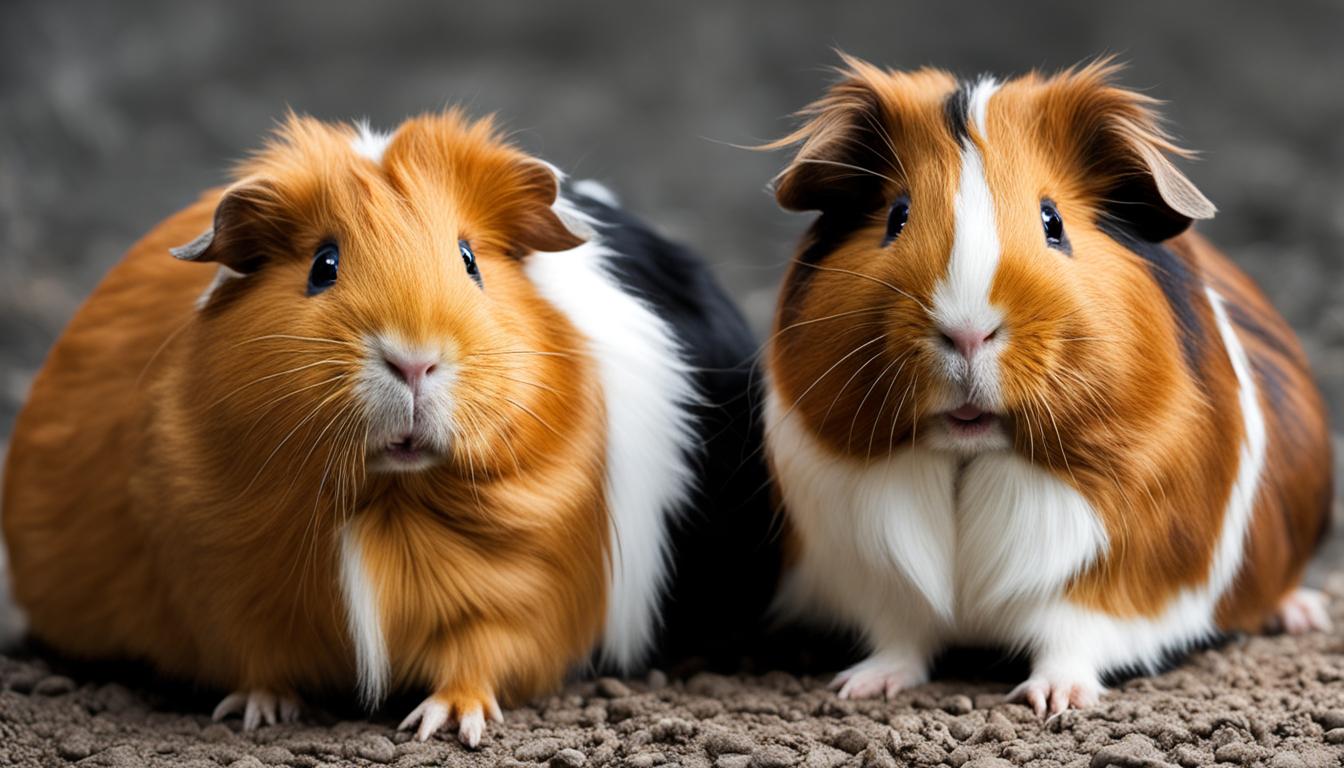Guinea pigs are adorable and curious creatures, known for their unique eating habits. But have you ever wondered if they store food in their cheeks like other rodents?
In this article, we will delve into the fascinating world of guinea pig eating habits and uncover the truth behind their food storage capabilities.
Contrary to popular belief, guinea pigs do not have cheek pouches like hamsters and squirrels. Therefore, they cannot store food in their cheeks. Instead, guinea pigs have a different strategy for managing their meals. When they eat, they keep some partially chewed and unswallowed food at the back of their mouth.
This unswallowed food can be easily scooped out by a veterinarian during dental examinations to assess their teeth’s condition.
Although guinea pigs do not have cheek pouches for food storage, they do have cheek pads, which are fat pads in their cheeks.
These cheek pads allow them to keep a small amount of food for a short time to chew on later. However, it is important to note that guinea pigs do not hoard food like rats.
They consume most of their food immediately and rely on a constant supply of fresh hay, vegetables, and pellets to maintain a balanced diet.
Key Takeaways:
- Guinea pigs do not have cheek pouches, unlike hamsters and squirrels.
- They keep partially chewed and unswallowed food at the back of their mouth.
- Guinea pigs may keep a small amount of food in their cheek pads, but they do not hoard food.
- If a guinea pig’s cheeks appear swollen, it may indicate dental issues, mouth abscesses, or lumps in the lymph nodes.
- Monitoring a guinea pig’s dental health is crucial for their overall well-being.
Anatomy of Guinea Pigs’ Cheeks
Unlike hamsters and other rodents, guinea pigs do not have cheek pouches to store food. However, they have a unique double-folded cheek opening that enhances their ability to grip and chew food effectively.
Guinea pigs rely on their teeth and strong jaw muscles to consume and break down their diet. The absence of cheek pouches in guinea pigs sets them apart from other rodents, including hamsters.
Guinea pigs’ oral anatomy and feeding habits have evolved to compensate for the lack of cheek pouches.
Their double-folded cheek opening allows for better control and manipulation of food while chewing.
Their teeth play a crucial role in the breakdown of plant fibers, such as hay and grass, which are essential components of their diet.
Guinea pigs are classified as herbivores and have adapted to their diet with unique dental structures.
In contrast to rodents with cheek pouches, guinea pigs do not hoard or store food for later consumption in their cheeks.
Instead, their unique cheek anatomy aids in efficient chewing and grinding of fibrous plant material.
The dental formula of guinea pigs consists of two upper and two lower incisors, a set of premolars, and molars.
These teeth continually grow throughout their lives, ensuring they can adequately process their food intake.
Because of their distinct oral anatomy and the absence of cheek pouches, guinea pigs require a consistent supply of fresh hay and other fibrous foods to maintain proper dental health.
Regular monitoring of their teeth and seeking veterinary attention for any dental issues is crucial for their overall well-being.
Dental Issues in Guinea Pigs
Guinea pigs, like many other rodents, have teeth that continuously grow throughout their lives. To keep their teeth at the proper length, guinea pigs need to chew on hay and other rough materials.
However, sometimes their teeth can become misaligned or overgrown, leading to various dental issues.
One common dental problem in guinea pigs is overgrown teeth. When a guinea pig’s teeth grow too long, they can cause injuries to their tongue, gums, and cheeks, resulting in discomfort and puffy cheeks.
These dental issues can make it difficult for guinea pigs to eat and can lead to significant weight loss and lethargy.
If you notice that your guinea pig’s cheeks appear swollen or puffy, it is crucial to seek immediate veterinary attention.
A veterinarian specializing in exotic animals can determine the cause of the dental issue and provide appropriate treatment.
This may involve filing down the overgrown teeth or extracting them if necessary.
To prevent dental issues in guinea pigs, it is essential to provide them with a proper diet and plenty of opportunities to chew.
A diet rich in hay, fresh fruits, and vegetables can help wear down their teeth naturally. Additionally, providing guinea pigs with chew toys and objects like wooden blocks can also help keep their teeth in good condition.
Taking care of your guinea pig’s dental health is crucial for their overall well-being. By being aware of the signs of dental issues, such as puffy cheeks and overgrown teeth, and seeking veterinary care promptly, you can ensure that your furry friend maintains good oral health and enjoys a happy and healthy life.
Abscesses in Guinea Pigs

Guinea pigs are delightful and adorable pets that require specific care to ensure their well-being.
Unfortunately, they are prone to cuts and punctures on their face, which can lead to infections and the formation of abscesses.
When a guinea pig develops an abscess, it can cause their cheeks to appear swollen and exhibit discomfort.
These abscesses in guinea pigs can be caused by various factors, such as wounds from sharp objects or bites from other animals.
The bacteria present can infect the wound, resulting in the formation of an abscess. The swelling caused by the abscess can make the guinea pig’s cheeks puffy and painful.
Treatment for abscesses in guinea pigs usually involves lancing the abscess to drain the pus, cleaning the wound thoroughly, and administering antibiotics to fight the infection.
In severe cases, the guinea pig may need to stay at the veterinarian for a few days to receive proper care and treatment.
It’s important to note that abscesses can also develop inside the mouth of a guinea pig, making treatment more challenging.
In such cases, veterinarians may need to use additional techniques and medications to ensure effective healing and recovery.
As a guinea pig owner, it is crucial to keep a close eye on your pet for any signs of abscesses or swelling in their cheeks.
Prompt veterinary attention is necessary if you notice any abnormalities, as untreated abscesses can lead to further complications and discomfort for your furry friend.
Lumps in Guinea Pigs
When it comes to guinea pigs, lumps can be a cause for concern. Unlike abscesses, which are localized infections, lumps in guinea pigs typically form in the lymph nodes along the neck and under the jaw.
One visible sign of these lumps is puffy cheeks. When the lumps develop under the jaw, the cheeks may appear swollen or puffed up.
If you notice your guinea pig’s cheeks looking larger than usual, it’s essential to investigate further.
Lumps in the lymph nodes can spread quickly if left untreated. In addition to antibiotic therapy, surgery may be necessary to remove the lumps and prevent further complications.
If you suspect your guinea pig has lumps or lymph node issues causing puffy cheeks, it’s important to consult a cavy-savvy veterinarian.
They can provide a proper diagnosis, recommend treatment options, and guide you through the surgery process if needed.
What to Look For:
- Puffy cheeks
- Visible lumps or swelling under the jaw
- Any changes in behavior, appetite, or activity levels
- Weight loss or lethargy
If you observe any of these signs in your guinea pig, don’t delay in seeking veterinary care. Early detection and treatment can make a significant difference in your guinea pig’s health and well-being.
Differences Between Guinea Pigs and Hamsters

While guinea pigs and hamsters may appear similar at first glance, there are some significant differences between these two adorable creatures.
Understanding these differences can help you choose the right pet for your lifestyle and preferences.
Size
One of the most noticeable differences between guinea pigs and hamsters is their size. Guinea pigs are generally larger than hamsters, with an average length of 8 to 10 inches (20 to 25 cm) and weighing around 2 to 3 pounds (0.9 to 1.4 kg).
On the other hand, hamsters are much smaller, measuring about 2 to 4 inches (5 to 10 cm) in length and weighing only a few ounces.
Diet
When it comes to their diet, guinea pigs and hamsters have different nutritional requirements. Guinea pigs are herbivores, which means their diet consists mainly of hay, fresh vegetables, and pellets formulated specifically for their needs.
On the other hand, hamsters are omnivores and can consume a mix of grains, seeds, fruits, vegetables, and even insects.
Sociability
Another notable difference between guinea pigs and hamsters is their sociability. Guinea pigs are social animals that enjoy interacting with their owners and other animals, including humans.
They thrive in the company of their own kind and should ideally be kept in pairs or small groups. On the other hand, hamsters are more solitary creatures and are best kept alone to prevent aggression and territorial disputes.
To sum it up, guinea pigs and hamsters differ in terms of size, diet, and sociability. Guinea pigs are larger, herbivorous, and highly sociable animals that thrive in the company of others.
Hamsters, on the other hand, are smaller, omnivorous, and generally prefer to live alone. Before bringing home a new pet, it’s important to consider these differences and choose the right furry friend that aligns with your preferences and ability to provide the care they need.
Conclusion
Guinea pigs, unlike hamsters, do not have cheek pouches for food storage. Instead, they rely on their teeth and strong jaw muscles to consume and break down food.
While guinea pigs may keep a small amount of partially chewed food in their cheek pads, they do not hoard food like rats.
If a guinea pig’s cheeks appear puffy, it could indicate dental issues, abscesses, or lumps in the lymph nodes.
Maintaining good dental health is essential for guinea pigs. They need regular vet check-ups to ensure their teeth are not misaligned or overgrown, causing pain and difficulty eating.
Additionally, any puffy cheeks should be examined by a cavy-savvy veterinarian to rule out abscesses or lumps.
Monitoring their dental health and seeking prompt veterinary attention for any issues is crucial for the overall well-being of guinea pigs.
Remember, guinea pigs rely on their teeth and jaw muscles for their food, and their puffy cheeks may be indicative of underlying dental issues or other health concerns.
Staying proactive by providing a healthy diet, regular dental checks, and seeking professional help when necessary will help keep your guinea pig happy and healthy.
Frequently Asked Questions
Q: Do guinea pigs have pouches in their cheeks?
A: No, guinea pigs do not have pouches in their cheeks like some other rodents, such as hamsters. They do not have the ability to store food in their cheeks.
Q: Do guinea pigs keep food in their mouths?
A: Guinea pigs do not keep food stored in their mouths. They chew and swallow food rather than hoarding it in their cheeks or mouths.
Q: Do guinea pigs hoard food like rats?
A: Guinea pigs do not typically hoard food like rats or hamsters. They usually eat their food when it is provided rather than storing it for later consumption.
Q: What does it mean if a guinea pig’s cheeks appear swollen?
A: Swollen cheeks in guinea pigs can be a sign of dental problems, an abscess, or an infection. It is important to consult a veterinarian if you notice swelling in your guinea pig’s cheeks.
Q: What can cause abscesses in guinea pigs’ cheeks?
A: Abscesses in guinea pigs’ cheeks can be caused by dental issues, injuries, or infections. Abscesses are pockets of pus that need to be treated by a veterinarian to prevent further health complications.
Q: How are lumps in guinea pigs different from abscesses?
A: Lumps in guinea pigs can be caused by various factors including cysts, tumors, or abscesses. An abscess is typically a painful, pus-filled lump caused by infection, whereas other types of lumps may vary in cause and composition. Veterinary diagnosis is essential for proper treatment.




